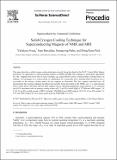| dc.contributor.author | Iwasa, Yukikazu | |
| dc.contributor.author | Hahn, Seung-Yong | |
| dc.contributor.author | Park, Dong Keun | |
| dc.contributor.author | Bascunan, Juan | |
| dc.date.accessioned | 2014-11-20T14:56:45Z | |
| dc.date.available | 2014-11-20T14:56:45Z | |
| dc.date.issued | 2012-09 | |
| dc.identifier.issn | 18753892 | |
| dc.identifier.uri | http://hdl.handle.net/1721.1/91644 | |
| dc.description.abstract | This paper describes a solid-cryogen cooling technique currently being developed at the M.I.T. Francis Bitter Magnet Laboratory for application to superconducting magnets of NMR and MRI. The technique is particularly appropriate for “dry” magnets that do not rely on liquid cryogen, e.g., liquid helium (LHe), as their primary cooling sources. In addition, the advantages of a cryocirculator (a combination of a cryocooler and a working fluid circulator) over a cryocooler as the primary cooling source for dry magnets are described. The four magnets described here, all incorporating this cooling technique described and currently being developed at the FBML, are: 1) a solid-nitrogen (SN[subscript 2])-cooled Nb[subscript 3]Sn 500-MHz/200-mm MRI magnet with an operating temperature range between 4.2 K (nominal) and 6.0 K (maximum with its primary cooling source off); 2) an SN[subscript 2]-cooled MgB[subscript 2] 0.5-T/800-mm MRI magnet, 1015 K; 3) an SN[subscript 2]-cooled compact YBCO “annulus” 100-MHz/9-mm NMR magnet, 10-15 K; 4) an SN2-cooled 1.5T/75-mm NbTi magnet for slow magic-angle-spinning NMR/MRI, 4.5-5.5 K. | en_US |
| dc.language.iso | en_US | |
| dc.publisher | Elsevier | en_US |
| dc.relation.isversionof | http://dx.doi.org/10.1016/j.phpro.2012.06.303 | en_US |
| dc.rights | Creative Commons Attribution | en_US |
| dc.rights.uri | http://creativecommons.org/licenses/by-nc-nd/3.0/ | en_US |
| dc.source | Elsevier | en_US |
| dc.title | Solid-Cryogen Cooling Technique for Superconducting Magnets of NMR and MRI | en_US |
| dc.type | Article | en_US |
| dc.identifier.citation | Iwasa, Yukikazu, Juan Bascunan, Seungyong Hahn, and Dong Keun Park. “Solid-Cryogen Cooling Technique for Superconducting Magnets of NMR and MRI.” Physics Procedia 36 (2012): 1348–1353. | en_US |
| dc.contributor.department | Massachusetts Institute of Technology. Plasma Science and Fusion Center | en_US |
| dc.contributor.department | Francis Bitter Magnet Laboratory (Massachusetts Institute of Technology) | en_US |
| dc.contributor.mitauthor | Iwasa, Yukikazu | en_US |
| dc.contributor.mitauthor | Bascunan, Juan | en_US |
| dc.contributor.mitauthor | Hahn, Seung-Yong | en_US |
| dc.contributor.mitauthor | Park, Dong Keun | en_US |
| dc.relation.journal | Physics Procedia | en_US |
| dc.eprint.version | Final published version | en_US |
| dc.type.uri | http://purl.org/eprint/type/JournalArticle | en_US |
| eprint.status | http://purl.org/eprint/status/PeerReviewed | en_US |
| dspace.orderedauthors | Iwasa, Yukikazu; Bascunan, Juan; Hahn, Seungyong; Park, Dong Keun | en_US |
| dc.identifier.orcid | https://orcid.org/0000-0001-5712-7350 | |
| dspace.mitauthor.error | true | |
| mit.license | PUBLISHER_CC | en_US |
| mit.metadata.status | Complete | |
